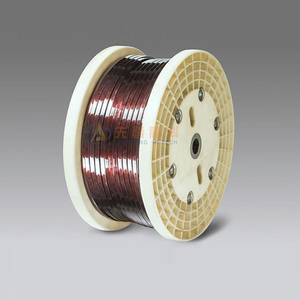How To Measure The Specifications Of Round Enameled Copper Wire?
Body
How to measure the specifications of enameled wire? The specific measurement method of enameled wire? Enameled wire is a type of cable. The specification of enameled wire is expressed by the diameter of bare copper wire (unit: mm). The measurement of the enameled wire specification is actually the measurement of the diameter of the bare copper wire. Generally used for micrometer measurement, the accuracy of the micrometer can reach 0.01mm.
How to measure the specifications of Round Enameled Copper Wire?
There are direct measurement methods and indirect measurement methods for the measurement of enameled wire specifications (wire diameter).
Direct measurement
The direct measurement method is to directly measure the diameter of the bare copper wire. The paint layer of the enameled wire must be burned first, and then the fire method is used. The wire diameter of the enameled wire used in the series motor rotor of the electric tool is very small, and it needs to be burned several times in a short time when burning with fire, otherwise it may burn out and affect the efficiency. After burning, wipe the burnt paint with a cloth, and then measure it with a micrometer The diameter of the bare copper wire. The diameter of bare copper wire is the specification of enameled wire.
The patent leather of enameled wire can be burned with alcohol lamp or candle.
Indirect measurement
The indirect measurement method is to first measure the outer diameter of the enameled copper wire (including the paint), and then according to the outer diameter data of the enameled copper wire (including the paint). This method does not need to burn the enameled wire enameled leather, and is highly efficient. If you can know the specific model of the enameled copper wire, it will be more accurate to check the enameled wire specifications (wire diameter).
PS:
It should be noted that no matter which method is used, different root numbers or positions must be measured 3 times to ensure accurate measurement. When the data of the three measurements differ greatly, they may be used in parallel, which requires careful analysis.
No matter which method is used, the wire must be straightened before measurement to ensure accurate measurement. When the three measurement data are very different, it may also be caused by the time line not being straightened.
The direct measurement method is generally used for the measurement of the old wire (removing the winding), and the indirect measurement method is generally used for the measurement of the new winding, which is more convenient and faster.
The specific measurement method of enameled wire?
Measuring tool: Micrometer and micrometer, precision O.002mm
When the enameled round wire d<0.100mm, the measuring force is 0.1~1.0N, when d≥0.100mm, the measuring force is 1~8N; the measuring force of the enameled rectangular wire is 4-8N.
Outer diameter
(Circular line) When the nominal diameter of the conductor d≤0.200mm, measure the outer diameter at 3 locations 1m apart, record 3 measured values, and take the average value as the outer diameter.
When the conductor's nominal diameter d>0.200mm, measure the outer diameter 3 times along the circumference of each position at two positions 1m apart, record 6 measured values, and take the average value as the outer diameter.
(Flat line) Measure the dimensions of the wide side and the narrow side at 3 positions 100mm apart, and take the average of the three measurements as the overall dimensions of the wide side and the narrow side.
Conductor size
(Round wire) When the nominal conductor diameter d≤0.200mm, use any method that does not damage the conductor at 3 places separated by 1m to peel off the insulating layer, and measure the conductor diameter once: take the average value as the conductor diameter.
When the nominal diameter of the conductor d>O.200mm, remove the insulating layer by any method that does not damage the conductor, measure three equally divided positions along the conductor circumference, and take the average of the three measured values as the conductor diameter.
(Rectangular Enameled Copper Wire ) At 3 positions every 100mm, remove the insulating layer by any method that does not damage the conductor, measure the dimensions of the wide side and the narrow side respectively, and take the average of the three measured values as the conductor size of the wide side and the narrow side .













Comments